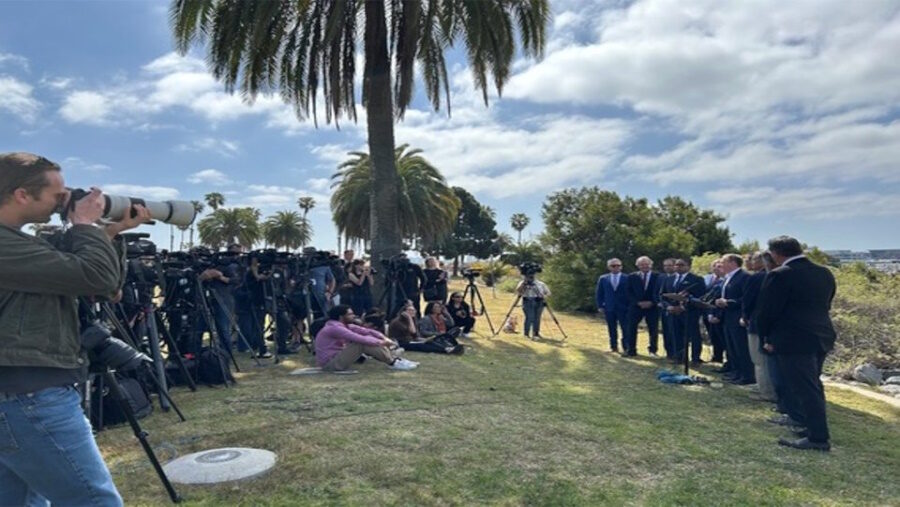
EPA Chief Demands Urgent Action by Mexico to Fix Tijuana Sewage Problems

US Environmental Protection Agency Administrator Lee Zeldin said April 22 that Mexico needs to stop the flow of billions of gallons of raw sewage and toxic chemicals into the Tijuana River that has polluted the Pacific Ocean off neighboring Southern California, closed beaches, created toxic hotspots in the river and even sickened Navy SEALs who train in the water on the U.S. side of the border.
Zeldin’s Earth Day trip to the California-Mexico border also included a tour of the South Bay International Wastewater Plant on the U.S. side of the border—which is being expanded to deal with the sewage flows from Mexico and recently received $250 million in federal funding for the project—and a meeting with Navy personnel, including the SEALs, and a helicopter tour of the border with the U.S. Customs and Border Patrol. The EPA administrator also cited U.S. military readiness as being affected by the sewage crisis.
“The Americans on our side of the border who have been dealing with this … for decades, are out of patience,” Zeldin said at a press conference at a Marine Corps Recruit Depot in San Diego. “There’s no way that we are going to stand before the people of California and ask them to have more patience and just bear with all of us as we go through the next 10 or 20 or 30 years of being stuck in 12 ft of raw sewage and not getting anywhere.”
Zeldin said that in the coming days, EPA will present Mexico a list of projects to resolve the environmental crisis in the Tijuana River Valley. Sewage flows and chemicals from an expanding manufacturing base on the Mexican side of the border have been crossing into southern San Diego County via the river for decades.
As a result, community beaches have began closing, and residents have experienced air quality warnings since 2018. Currently, Mexico’s miltary is working on a new international collector project meant to better contain and catch sewage flows on the Mexican side of the border. Part of that project, however, required sending 5 million gallons of raw sewage a day into the Tijuana River starting on April 9, according to the Mexican government. EPA estimates 100 billion gallons of raw sewage and pollutants have flowed into the Pacific Ocean via the Tijuana River since 2018.
“They told us this was a difficult decision and spent days looking at other alternatives,” said Maria-Elena Giner, outgoing commissioner for the U.S. section of the International Boundary and Water Commission, a treaty-created federal agency charged with negotiating border issues with Mexico.
“In the end,” she added, “the team working 24/7 on this complex and extremely important project felt they had exhausted all other options and found a path to mitigate the amount of flow to the river from a potential of about 25 [million gallons per day] to 5 MGD.”
The latest step involves drying a juinction box so it can be rebuilt with reinforced concrete. That will require diverting the flow, most of which will continue to be sent to the Mexican coast, but still about 5 MGD will go to the river, Giner said April 9.
Among those joining Zeldin at the event were Representatives Darrell Issa (R-Calif.), Juan Vargas (D-Calif.), Mike Levin (D-Calif.) and Sara Jacobs (D-Calif.), former Representatives Mike Garcia and Brian Bilbray, and the newly appointed commissioner for the U.S. Section of the (IBWC) Chad McIntosh, who replaces Giner.
“We look forward to continuing our work to eliminate dry-weather transboundary flows from Mexico and improve the health and welfare of communities in the border. This includes rehabilitating and expanding our wastewater treatment plant and monitoring Mexico’s sanitation infrastructure improvements,” said Frank Fisher, chief of public affairs at the U.S. section of the boundary commission.
The group toured multiple locations along the border, and the South Bay plant, to see the impact on residents and their communities.
Zeldin’s trip also included an April 21 meeting with Alicia Bárcena, secretary of the Environment and Natural Resources of Mexico, and other Mexican officials for what he said was a discussion “about ending decades of raw sewage entering the U.S. from Mexico.”
“It was clear in the way that the Mexican environmental secretary approached every aspect of this meeting yesterday … that she wants to have a strong collaborative relationship,” Zeldin said. “I welcome that collaboration.”
Imperial Beach Mayor Paloma Aguirre, one of the local officials present when Zeldin toured the wastewater treatment facility, said she wants action. San Diego County has joined legal action by residents to get the federal government to stop the sewage flows.
“It’s absolutely pivotal that we get this done as fast as possible,” Aguirre said.
For years, Aguirre and other mayors have called for the EPA to declare the entire South Bay of San Diego County a superfund site. Aguirre’s most-recent request was denied by Zeldin on March 14, but his invoking of military readiness may put such a request back on the table at EPA.
“The plan needs to be all-encompassing to end this crisis,” Zeldin said. “It must all be finished as rapidly as possible, and it must be” completed in a way that also plans for the future, with Tijuana’s population continuing to increase.”
He added a note of “hope this is the start of a new collaborative relationship … one laser-focused on cleaning up the river and keeping it clean for decades to come.”.
Post a Comment
You must be logged in to post a comment.





